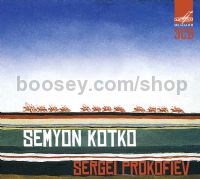Semyon Kotko (Melodia Audio CD x3)
Semyon Kotko (Melodia Audio CD x3)
Special Offer
* Estimated price converted from UK retail price
An opera in five acts, seven scenes, ?p. 81
Libretto by Valentin Katayev and Sergei Prokofiev after Katayev’s novel Son of Working People
Place: Ukraine
Time: 1918
Premiered at the Stanislavsky Opera Theatre, 23 June 1940, Moscow
Firma Melodiya presents a recording of one of Sergey Prokofiev’s least frequently performed operas, Semyon Kotko. It was the first opera Prokofiev composed after he returned to the Soviet Union. It took him a long time to find a source for the plot. “I wanted to have living people with their passions, love, hate, joy and sorrow naturally ensuing from the new conditions”, the composer remembered. Prokofiev eventually chose a novel titled “I, Son of Working People” by Valentin Katayev who agreed to rework it into an opera libretto. Vsevolod Meyerhold, a director, old friend and companion, was supposed to stage the new opera but he fell victim to the Stalinist terror.
The opera was premiered in 1940 in Moscow and, as was the case with other outstanding works of that time, was a great success with the public and severely criticized ‘from above’. Even today, bright and figurative music of Semyon Kotko, with its genuinely Gogol-esque humour and genre scenes from everyday life of a Ukrainian village, neat descriptions of the characters, passionate dramatism and monumental chorus scenes, cannot leave a keen listener indifferent.
The opera Semyon Kotko was recorded in 1960 by soloists of the Moscow opera theatres and the All-Union Radio Choir and Orchestra conducted by Mikhail Zhukov. This remarkable musician was taught by Nikolai Golovanov and Konstantin Stanislavsky. The latter acknowledged Zhukov as an “exemplary music director who was able to decrypt the life of human spirit hidden in the score and explain it to an actor”. Zhukov conducted at the premiere of Semyon Kotko at the Stanislavsky and Nemirovich-Danchenko Music Theatre, and its recording became the conductor’s last work.




